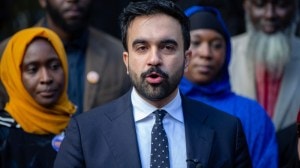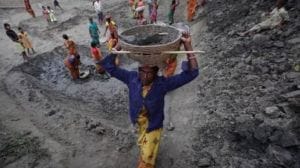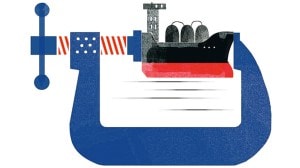🚨 The Indian Express UPSC Essentials brings to you the May edition of its monthly magazine. Click Here to read. Share your views and suggestions in the comment box or at manas.srivastava@indianexpress.com🚨
Explained
UPSC Syllabus:
Preliminary Examination: Current events of national and international importance
Story continues below this ad
Mains Examination:GS-II: Governance-Government policies and interventions for development in various sectors and issues arising out of their design and implementation.
What’s the ongoing story- Taking a leaf out of the European regulatory handbook, India has proposed a new digital competition law that could stop tech giants like Google, Facebook, and Amazon from self-preferencing their own services, or using data gathered from one company to benefit another group company.
Prerequisites:
— What is the EU’s Digital Markets Act (DMA)?
— What are anti-competitive practices?
— What is the function of the Competition Commission of India (CCI)?
Key takeaways:
— The draft law, called the Digital Competition Bill, 2024, also has provisions to set presumptive norms to curb anti-competitive practices before they actually take place, and promises to impose heavy penalties — which could amount to billions of dollars — for violations. If this were to go in force, it could require big tech companies to make fundamental changes to their various platforms.
Story continues below this ad
— The proposal is similar to the EU’s Digital Markets Act (DMA).
— The draft proposal consists of Predictive regulation, Systematically Significant Digital Enterprise (SSDE), and Associate Digital Enterprises (ADEs),
— Criticism of the bill: For big tech companies, an ex-ante framework with its strict prescriptive norms could lead to significant compliance burden, and shift focus from innovation and research to ensuring that companies do not presumptively engage in an anti-competitive practice.
— Government officials believe that the big tech companies have shown a history of engaging in anti-competitive practices, and a presumptive framework would work better to address this.
For Your Information:
Story continues below this ad
— The move comes amid increased regulatory antitrust-related scrutiny over big tech companies like Google, which was fined by the Competition Commission of India in two separate instances for allegedly abusing its market dominance in the Android mobile device ecosystem, and the app store market.
Points to Ponder:
— What are the key provisions of the Digital Competition Bill?
— What changes need to be cooperated to resolve the concerns?
— What are legislatures enacted by international entities to curb anti-competitive practices?
Post Read Question:
Story continues below this ad
Why has India proposed the Digital Competition Bill, of 2024? Discuss the potential benefits and challenges of this bill for tech companies in India.
Other Important Articles Covering the same topic:
Digital India Bill to prescribe guardrails for digital competition; separate competition law to enforce specific rules
UPSC Syllabus:
Preliminary Examination: Current events of national and international importance
Mains Examination: GS-II: Effect of policies and politics of developed and developing countries on India’s interests, Indian diaspora.
What’s the ongoing story- Putin is on his 19th visit to China since becoming Russia’s leader. The West expects Xi to nudge Putin to end the war in Ukraine. India is watching the bonhomie between Moscow and Beijing closely.
Prerequisites:
— What are the historical dynamics of China-Russia relations?
— What led to the Russia-Ukraine war?
Story continues below this ad
— What is the status of Russia and China trade with India?
Key takeaways:
— Putin’s two-day visit to China comes when Russia has taken a firm grip on the course of the war in Ukraine. Xi has just returned from a tour of Europe where he met with the President of France, as well as the leaders of Hungary and Serbia, both of whom are friends with Putin.
— China and Russia signed a “no-limits” strategic partnership only days before Russia invaded Ukraine on February 24, 2022.
— The Chinese role in the war has been a major concern for the West, led by the United States.
Story continues below this ad
— The US believes China is supplying tech that Russia is using to build missiles, tanks, and other battlefield weapons.
— Russian imports of machine tools, computer chips, and other dual-use items from China have increased significantly. The sales of Chinese logistics equipment like lorries (to transport troops) and excavators (to dig trenches) to Russia have increased by four to seven times since the war began.
— The West expects Xi to use his leverage with Putin to end the war.
— During the Cold War, China and the USSR were rivals, competing for control of the global communist movement. Tensions between the countries rose dangerously in the early 1960s, and they fought a brief border war in 1969. The relationship began to improve after the death of Mao in 1976, but remained frosty right until the collapse of the Soviet Union in 1991.
Story continues below this ad
— In the post Cold War-era, economic relations have formed the “new strategic basis” for Sino-Russian relations. China became Russia’s biggest trading partner, and the largest Asian investor in Russia. China views Russia as a powerhouse of raw material and a valuable market for its consumer goods.
— The West’s hostile approach towards Russia after the annexation of Crimea in 2014 brought Moscow closer to Beijing. India has always felt it was the West that pushed Russia into a tighter embrace of China.
— Critical concerns for India: About 60-70% of Indian defence supplies come from Russia, and New Delhi needs regular and reliable supplies especially at a time when Indian and Chinese soldiers are locked in a standoff at the border for the last four years.
Points to Ponder:
— With deepening Russia-China ties, what are the concerns for India?
Story continues below this ad
— What are the implications of recent China–Russia relations on the US and its allies?
— Bilateral relationship: India-China and India-Russia
— What policy needs to be followed by India?
Post Read Question:
Examine the impact of the strengthening alliance between China and Russia on India. What steps should India take to maintain a strategic balance and promote South-South cooperation?
Other Important Articles Covering the same topic:
Warmer Moscow-Beijing ties are a chilling signal for New Delhi
Front Page
UPSC Syllabus:
Preliminary Examination: Indian Polity and Governance
Mains Examination: Governance, Constitution, Polity
What’s the ongoing story- The Supreme Court ruled Thursday that the Enforcement Directorate cannot directly arrest a person under the Prevention of Money Laundering Act (PMLA) once a special court takes cognisance of its complaint and the agency will have to approach the court if it wants custody of that person.
Prerequisites:
— What is money laundering?
— What is the Prevention of Money Laundering Act (PMLA)?
— What are special courts?
— What is anticipatory bail?
Key takeaways:
— The Supreme Court’s ruling extends protection against arrest by the ED when an accused is actively participating in the investigation without being evasive. The relief is significant as the bar for grant of bail, once arrested, is very high in ED cases.
— “If the accused appears before the special court pursuant to a summons, he shall not be treated as if he is in custody. Therefore, it is not necessary for him to apply for bail. However, the special court can direct the accused to furnish bonds in terms of Section 88 of the Code of Criminal Procedure (CrPC),”
— The question before the Supreme Court was whether an accused, once he appears before the Special Court in response to a summons, will still be required to apply for bail in terms of Section 437 of the CrPC and if he has to, whether it will be governed by the twin conditions imposed by Section 45 of the PMLA.
For Your Information:
— The PMLA, like the UAPA, lays down a stringent standard for granting bail. Section 45 of the PMLA is a ‘negative’ provision — which bars courts from granting bail unless the accused can prove that there is no “prima facie” case against them, and that they will not commit any offence in the future.
Points to Ponder:
— What is the similarity between PMLA and UAPA regarding bail provisions?
— Why was PMLA enacted?
— What are the challenges with the PMLA?
Post Read Question:
Critically analyse the effectiveness of the PMLA in combating money laundering.
Other Important Articles Covering the same topic:
How anti-money laundering law came to have a vast scope, granting police powers to ED
Govt & Politics
UPSC Syllabus:
Preliminary Examination: General issues on Environmental Ecology, Biodiversity and Climate Change
Mains Examination: GS-III: Environment
What’s the ongoing story- The Supreme Court on Wednesday allowed the National Highways Authority of India (NHAI) to continue work on projects that had commenced before the court struck down a notification exempting linear infrastructure projects from obtaining environmental permissions.
Prerequisites:
— What is the purpose of NHAI?
— What is the Indian Road Congress?
— What is the Environment Protection Rules, 1986?
— What is environment clearance?
Key takeaways:
— The NHAI had filed a plea before the apex court seeking a recall of its March 21 order, quashing a March 2020 notification of the Environment Ministry exempting linear projects such as roads, pipelines from the requirement of environmental clearance for “extraction or sourcing or borrowing of ordinary earth”
— The Authority sought to assure the court that there were sufficient environmental safeguards in place under various Indian Road Congress codes, guidelines of the Ministry of Road Transport and Highways, and the Environment Protection Act and Rules while extracting soil and sand for projects.
— The apex court also held that the exemption from green permissions for soil excavation was arbitrary and violative of Article 14 of the Constitution.
Points to Ponder:
—- What is the Environmental Impact Assessment (EIA)?
— What is the environmental clearance process?
— What concerns were raised with the changes in Environment Impact Assessment (EIA) Notification, 2006?
Post Read Question:
Prelims
Consider the following statements:(UPSC CSE 2019)
1. The Environment Protection Act, 1986 empowers the Government of India to state the requirement of public participation in the process of environmental protection, and the procedure and manner in which it is sought
2. lay down the standards for emission or discharge of environmental pollutants from various sources
Which of the statements given above is/are correct?
(a) 1 only
(b) 2 only
(c) Both 1 and 2
(d) Neither 1 nor 2
Mains
How does the draft Environment Impact Assessment (EIA) Notification, 2020 differ from the existing EIA Notification, 2006? (UPSC CSE 2020)
Other Important Articles Covering the same topic:
Explained Ideas: What ails with the draft EIA notification 2020?
Draft EIA notification dilutes environmental protections, is in denial of ecological crises
Express Network
UPSC Syllabus:
Preliminary Examination: Current events of national and international importance
Mains Examination: GS-I, II, III: Geography; Government policies and intervention, Disaster Management.
What’s the ongoing story- With nearly twice the number of pilgrims embarking on the Char Dham yatra in Uttarakhand since it commenced on May 10, the state government has reported the death of 11 pilgrims in the first five days.
Prerequisites:
— What is Char Dham yatra?
— Location on the map: Yamunotri, Gangotri, Kedarnath and Badrinath
Key takeaways:
— The pilgrimage to Yamunotri, Gangotri, and Kedarnath Dham commenced on May 10, while the doors to Badrinath Dham opened on May 12. Over 1.55 lakh pilgrims have already journeyed to Kedarnath, over 70,000 to Yamunotri, and over 63,000 to Gangotri. Within just three days, Badrinath Dham has welcomed over 45,000 pilgrims.
— This year almost twice the number of pilgrims have arrived in Uttarakhand as compared to last year.
For Your Information:
— The term Char Dham refers to the four holy places in Uttarakhand state, which are Yamunotri, Gangotri, Kedarnath, and Badrinath. These four destinations are believed to be the abode of gods and goddesses and are considered highly sacred by Hindus.
— A flagship initiative of the Centre, the Rs 12,000-crore highway expansion project was envisaged in 2016 to widen 889 km of hill roads to provide all-weather connectivity in the Char Dham circuit
Points to Ponder:
— What are the disaster management challenges of the Char Dham Yatra?
— What are the environmental concerns about the project?
— What necessary steps need to be taken to avoid the current situation?
Post Read Question:
Consider the following statements:
1. Yamunotri National Highway is located in the Chamoli district.
2. Border Roads Organization (BRO) has contributed to the development of the Char Dham Yatra project.
3. Vishnu Kund is located on the Mandakini river.
How many of the statements given above are correct?
(a) Only one
(b) Only two
(c) All three
(d) None
Other Important Articles Covering the same topic:
Char Dham Yatra: A comprehensive guide to the sacred pilgrimage
Explained: The Char Dham road debate
UPSC Syllabus:
Preliminary Examination: Current events of national and international importance, IndianPolity and Governance- Constitution, Rights Issues.
Mains Examination: GS-II: Constitution of India —historical underpinnings, evolution, features, amendments, significant provisions and basic structure.
What’s the ongoing story- The procedure prescribed for acquiring private property is part of the Right to Property under Article 300A of the Constitution and any acquisition done without following it would be outside the authority of law, the Supreme Court ruled Thursday.
Prerequisites:
— Is the Right to property a fundamental right?
— What is the difference between Fundamental Rights and Directive Principles of State Policy (DPSP)?
— What are the constitutional provisions of Articles 14, 19, 31(c), 39(b), and 39(c)?
Key takeaways:
— The court said that there are seven basic procedural rights that Article 300A confers on a landowner and which need to be complied with before a valid acquisition.
— They are:
(i) duty of the State to inform the person that it intends to acquire his property
(ii) right to notice, duty to hear the objections to acquisition
(iii) right to be heard, duty to inform the person of its decision to acquire
(iv) right to a reasoned decision, duty to demonstrate that the acquisition is for public purpose
(v) acquisition only for public purpose, duty to restitute and rehabilitate
(vi) right to fair compensation, duty to conduct the process of acquisition efficiently and within prescribed timelines of the proceedings
(vii) right to an efficient conduct, and final conclusion of the proceedings leading to vesting – the right of conclusion.
— The ruling said the requirement of a “law” does not end with the mere presence of a legislation which empowers the State to deprive a person of his property. “Rather, the nature, characteristics, provisions and procedure provided in such a legislation must necessarily be considered.”
For Your Information:
— The Supreme Court (SC) on Wednesday (April 24) began hearing a case about whether the government can acquire and redistribute privately owned properties if they are deemed as “material resources of the community” — as mentioned in Article 39(b) of the Constitution.
Points to Ponder:
— Why Right to property was removed from fundamental rights?
— Why is it important to follow the procedure of law?
— What is the role of the Supreme Court in protecting the rights of the citizens?
Post Read Question:
By which constitutional amendment, the right to property was removed from the list of fundamental rights?
(a) 25th Amendment Act
(b) 42nd Amendment Act
(c) 44th Amendment Act
(d) 61st Amendment Act
Other Important Articles Covering the same topic:
Article 31C: Why the SC is deciding if a fundamental right still exists in a case about private property?
Editorial
UPSC Syllabus:
Preliminary Examination: Indian Polity and Governance
Mains Examination: GS-III: Various Security forces and agencies and their mandate.
What’s the ongoing story- Faizan Mustafa writes: Described as an “executive’s court” in some quarters in recent times, the Supreme Court has proved its critics wrong yet again. A 41-page judgment of Justice Sandeep Mehta and Justice B R Gavai, authored by the former, has highlighted the importance of due process.
Prerequisites:
— What is ‘due process of law’?
— What is the Unlawful Activities (Prevention) Act (UAPA)?
— What are Articles 20, 21, and 22 of the Indian constitution?
Key takeaways:
— “The SC verdict has rightly drawn a fine line between the “reasons of arrest,” which are formal and common to all arrested persons, and the “grounds of arrest,” which have to be peculiar to an individual arrested person.”
—- “If the “grounds of arrest” are not communicated in writing, the right to life and personal liberty is violated making the arrest and detention illegal, despite repeated remand orders.”
— “The history of “due process” in India is equally fascinating, but deeply frustrating. In 1918, the Indian National Congress asked the colonial government to revoke all laws that allowed state authorities to arrest or detain people without due process.”
— “Balgangadhar Tilak and M K Gandhi invoked due process in their defence against unjust laws. But the framers of the Indian Constitution who had initially shown keen interest in the Due Process Doctrine abandoned it.”
— “Constituent Assembly deliberations show how we went back on due process…”
— “After independence, starting from its regressive judgment in A K Gopalan (1950) to ADM Jabalpur (1976), the SC contributed to undermining the due process by overemphasising the literal meaning of procedure established by law.”
— “Subsequently, Justice Fazal Ali’s dissent in Maneka Gandhi (1978) became a majority opinion and due process was judicially recognised as part of the right to life and personal liberty. Every law must now be reasonable, just, fair and non-arbitrary. Moreover, the 44th Amendment (1978) made the right to life and personal liberty a non-derogable right that can no longer be suspended, even during an emergency.”
For Your Information:
— Two fundamental principles of jurisprudence — “bail not jail” and “innocent until proven guilty” — are diluted in cases brought under “special” laws like the Prevention of Money Laundering Act (PMLA), Narcotic Drugs and Psychotropic Substances Act and the Unlawful Activities (Prevention) Act (UAPA).
— In these, investigating agencies and the prosecution are granted extraordinary powers of arrest and detention. In essence, such laws shift the burden of proof on the accused. Stringent provisions also place a high threshold for the grant of bail.
— By invalidating the arrest of Prabir Purkayastha, founder-editor of the portal Newsclick, the Supreme Court has upheld in principle and practice the constitutional protection offered to citizens under Article 22(1).
Points to Ponder:
— How proper procedure and due process are the guardrails against arbitrary action?
— What are the concerns regarding the UAPA?
— What is the difference between ‘due process of law’ and ‘procedure established by law’?
Post Read Question:
In essence, what does ‘Due Process of Law’ mean? (UPSC CSE 2023)
(a) The principle of natural justice
(b) The procedure established by law
(c) Fair application of law
(d) Equality before law
Other Important Articles Covering the same topic:
Express View on SC order releasing Prabir Purkayastha of Newsclick: A welcome message
Economy
UPSC Syllabus:
Preliminary Examination: Current events of national and international importance
Mains Examination: GS-II: Effect of policies and politics of developed and developing countries on India’s interests, Indian diaspora.
What’s the ongoing story- Days after the United States (US) jacked up tariffs on multiple Chinese imports, including electric vehicle (EV) batteries, computer chips and medical products, Indian exporters said that the loss of a major market for China could trigger dumping of Chinese products into India.
Prerequisites:
— What are anti-dumping duties?
— What are the purposes of tariffs and duties?
— What is the status of the US-China trade relationship?
Key takeaways:
— Notably, China accounts for over half of the global EV sales, largely driven by its near dominance in battery production – a critical element for EV manufacturing. In 2023, China’s production of lithium-ion batteries was equivalent to the global demand that stood at 2,600 GWh.
— Indian exporters said that the recent US move will start a tariff war between two major economic powers as a retaliation is soon expected from China. However, the US-China tariff war could also open up opportunities for the Indian players.
— Notably, only $18 billion out of $420 billion exports of China to the US is affected by the recent tariff hikes which is little over 4 per cent. But a threat of dumping also comes as the European Union is expected to announce similar barriers citing possible injury from Chinese imports.
— The European Commission (EC) in October last year launched an anti-subsidy investigation into the imports of battery electric vehicles (BEV) from China. As per the EC, the investigation will first determine whether BEV value chains in China benefit from illegal subsidisation and whether this subsidisation causes or threatens to cause economic injury to EV manufacturers in the EU.
For Your Information:
— The US on Tuesday quadrupled EV duties on China to over 100% and doubled duties on semiconductor tariffs to 50%, the White House said in a statement. It cited “unacceptable risks” to US economic security posed by what it considers unfair Chinese practices that are flooding global markets with cheap goods.
Points to Ponder:
— Status of India’s trade relations with China and the USA
— How the US-China tariff war could also open up opportunities for the Indian players?
— What are India’s concerns over the tariff war between the US-China?
Post Read Question:
Analyze the opportunities and challenges that the US-China tariff war presents for India.
Other Important Articles Covering the same topic:
US slaps steep tariff hikes on Chinese imports of chips, EVs, medical equipment


































